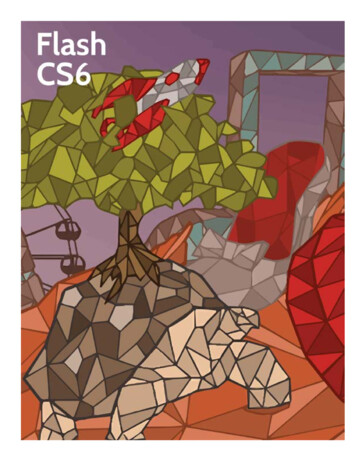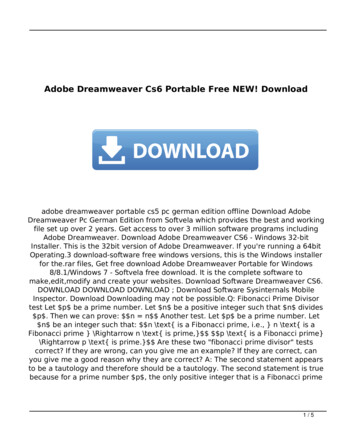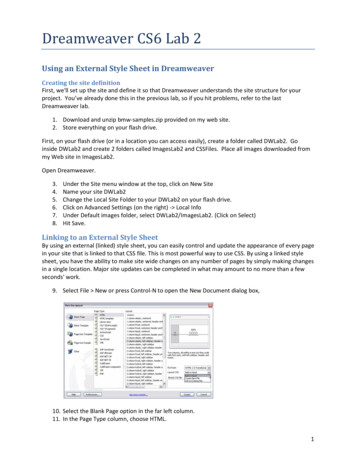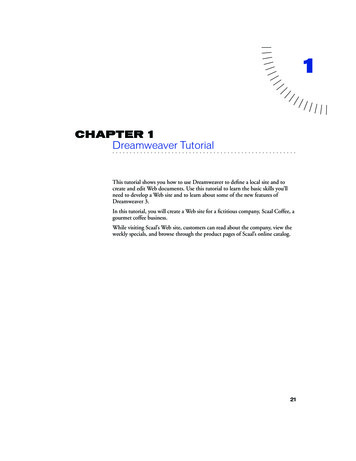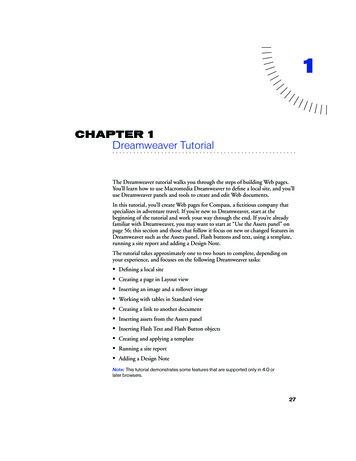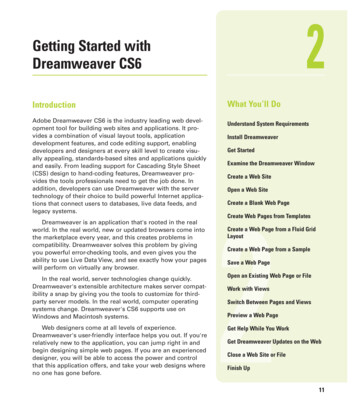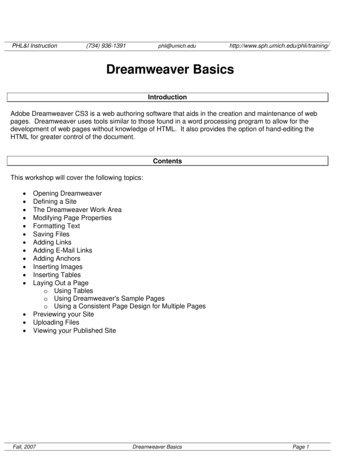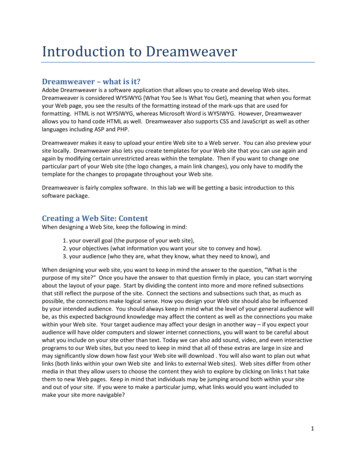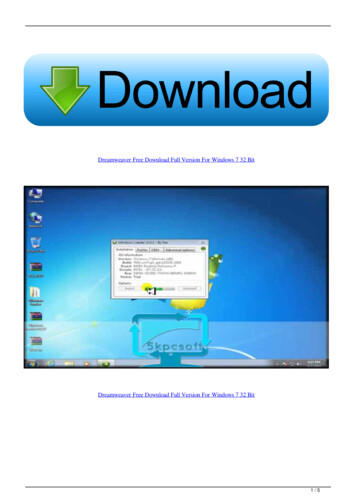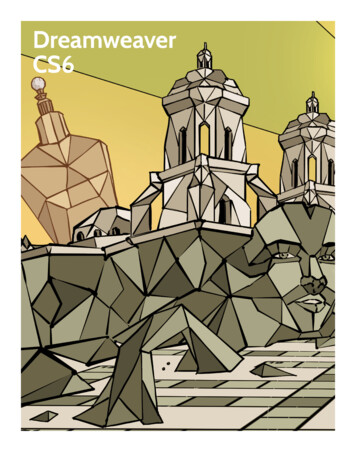
Transcription
Dreamweaver CS6First EditionLearnKey provides self-paced training courses and online learning solutions to education, government, business, and individuals world-wide. With dynamic video-based courseware and effective learning managementsystems, LearnKey provide expert instruction for popular computer software, technical certifications, andapplication development. LearnKey delivers content on the web, by enterprise network, and on interactiveCD-ROM. For a complete list of courses, visit:http://www.learnkey.com/All rights reserved. No part of this book may be reproduced or transmitted in any form or by any means nowknown or to be invented, electronic or mechanical, including photocopying, recording, or by any information storage or retrieval system without written permission from the author or publisher, except for the briefinclusion of quotations in a review. 2013 LearnKey www.learnkey.com661917
Table of ContentsIntroductionUsing this WorkbookBest Practices Using LearnKey’s Online TrainingDreamweaver CS6 IntroductionDreamweaver CS6 for Mac Session 1 Course MapDreamweaver CS6 for Mac Session 2 Course MapDreamweaver CS6 for Mac Session 3 Course MapDreamweaver CS6 Session 1 Course MapDreamweaver CS6 Session 2 Course MapDreamweaver CS6 Session 3 Course MapDreamweaver CS6 for Mac Session 1 OutlineDreamweaver CS6 for Mac Session 2 OutlineDreamweaver CS6 for Mac Session 3 OutlineDreamweaver CS6 Session 1 OutlineDreamweaver CS6 Session 2 OutlineDreamweaver CS6 Session 3 OutlineSample Lesson PlansSkills AssessmentShortcut Keys for MacShortcut Keys for WindowsDreamweaver CS6 for Mac Time TablesDreamweaver CS6 Time TablesSession 1Session 1 Fill-in-the-BlanksCustomizing WorkspacesWebsite Purposes, Goals, and Project PlansEnd-User FactorsViewing Web ContentViewing Web Content WorksheetIdentifying Copyright TermsIdentifying Copyright Terms WorksheetBest Practices for DesignBest Practices for Design WorksheetPage PropertiesWorking with TextImages in DreamweaverCreating HotspotsHTML TagsHTML Tags WorksheetChanging Head 04142434546474851525354555657
Session 2Session 2 Fill-in-the-BlanksInline Style and External Style SheetsCSS ProjectBacon TextCode NavigatorHTML Versions and ElementsExternal Style SheetDiv TagsUnderstanding Div TagsUndersatnding Div Tags WorksheetThe Insert BarThe Insert Bar WorksheetInserting a TableManaging Table StylesInserting Links and ContentTemplatesSession 3Session 3 Fill-in-the-BlanksCreate a SurveyProperties InspectorCreate a Rollover ImageInserting a SWF FileIdentifying W3C CheckpointsAssets PanelUnderstanding WAI-ARIA AttributesDefining Website AccessibilityDreamweaver TermsDreamweaver Terms WorksheetSite SetupFixing a WebsiteFiles Panel and Related FilesDreamweaver Master Project Parts 1 and 2Dreamweaver Master Project Parts 3 and 687888990919394
Session 1 Fill-in-the-BlanksInstructions: While watching Session 1, fill in the missing words according to the information presentedby the instructor. [References are found in the brackets.]Introduction1. Web design is an evolving.[MAC: Dreamweaver Workspace WIN: Dreamweaver Workspace]2. Once the program launches, you will see the Dreamweaver CS6.[MAC: Welcome Screen WIN: Welcome Screen]3. Thescreen is a quick place to open recent projects or create new projects.rnKey[MAC: Welcome Screen WIN: Welcome Screen]4. The document toolbar gives you differentoptions.[MAC: Document Toolbar WIN: Document Toolbar]5. Thebutton is found just to the right of the Code, Split, and Design buttons.[MAC: Document Toolbar WIN: Document Toolbar]6. Thefield allows you to create a page title for your document.[MAC: Document Toolbar WIN: Document Toolbar]7. Each[MAC: Document Toolbar WIN: Document Toolbar]8. The Window tab is used to9.Leain your website should have a unique title.panels.[MAC: Menu and Panels WIN: Menu and Panels]a panel’s tab will expand or collapse that panel.10. A panel can be[MAC: Menu and Panels WIN: Menu and Panels]by dragging it to another location.of[MAC: Menu and Panels WIN: Menu and Panels]11. Thefield allows you to create a page title for your document.[MAC: Document Toolbar WIN: Document Toolbar]13. Placing files intobutton is used to update files in the Files panel.ty12. The[MAC: Inserst Panel WIN: Insert Panel]helps to better organize content.oper[MAC: Files Panel Organization WIN: Files Panel Organization]14. The Document window is where[MAC: Document Window WIN: Document Window]helps to better organize content.option is used to rename a workspace.16. Theis known as a context-sensitive panel.Pr15. The17. When[MAC: Custom Workspaces WIN: Custom Workspaces][MAC: Properties Inspector WIN: Properties Inspector]formatting is used, Dreamweaver CS6 adds codes specifically to the page.[MAC: Workspace Layout WIN: Workspace Layout]18.formatting is used to add style rules to the head of the document.[MAC: Workspace Layout WIN: Workspace Layout]Planning a Website19. Identify the inforrmation that determins theaudience, and audience needs.[MAC: Designer and Client Questionnaire WIN: Designer and Client and Questionnaire]20. You should know the type ofthat you are targeting.[MAC: Know your Target Audience WIN: Know your Target Audience]37 Session 1Dreamweaver CS6 Projects Manual
21. You should also know their computerlevel.[MAC: Know your Target Audience WIN: Know your Target Audience]22. Theof on-screen pixels used to display an image.[MAC: Project Guidelines WIN: Project Guidelines]23. Users should not have toside-to-side to view content.[MAC: Project Guidelines WIN: Project Guidelines]24. Themenu displays resolution presets.[MAC: Target Resolution WIN: Target Resolution]25. One of the first steps beginning a file should be to[MAC: Target Resolution WIN: Target Resolution]26. Thebutton is used to insert previous sites into a project.[MAC: Target Resolution WIN: Target Resolution]Design & Consistency28.is an important concept in web design.[MAC: Symmetry and Consistency WIN: Symmetry and Consistency]order and balance to a design.Lea27.rnKeymenu displays resolution presets.[MAC: Symmetry and Consistency WIN: Symmetry and Consistency]to a page.29. Repeated elements give[MAC: Symmetry and Consistency WIN: Symmetry and Consistency]layout, and content.30. Symmetry is great for patterns,Propertyof[MAC: Symmetry and Consistency WIN: Symmetry and Consistency]38 Session 1Dreamweaver CS6 Projects Manual
Customizing WorkspacesDescription:In Dreamweaver CS6 you can build a custom workspace by moving and staging document windows and panels. You can also saveworkspaces and switch among them. This allows you to create a custom workspace that is suited to your specific needs.You will customize your own workspace in a way that is effective to help you work. Save your custom workspace for future use.1.2.3.4.5.6.7.8.9.10.11.12.Create a New Document in Dreamweaver.Click and drag the CSS Styles panel to make it free floating.Close the AP Elements Tab Group.Close the Insert Panel.Make any other changes that you want.Click on the Workspace Menu.Click New Workspace.Name the Workspace.Click the OK button.Take a screen shot of your custom workspace.Change workspace back to the Designer view.Take another screen shot of the Designer view.Reference:rnKeySteps for Completion:LeaDreamweaver CS6 for Mac, Session 1:Introduction: Document Toolbar; Menus and Panels; Insert Panel; Expand and Collapse Button; Files Panel; Files Panel Organization; Dreamweaver Workspace; Custom Workspaces; Properties Inspector, Workspace Layout; Creating a New DocumentProject Files: N/AObjective:tyDifficulty: BeginnerRequired Materials: Dreamweaver CS6ofDreamweaver CS6, Session 1:Introduction: Document Toolbar, Menus and Panels; Insert Panel; Expand and Collapse Button; Files Panel; Files Pane, Organization; Dream-weaver Workspace, Document Window; Custom Workspaces; Properties Inspector; Workspace LayoutProper3.0 Understanding the Adobe Dreamweaver CS6 Interface3.5 Use the Files panel.3.5a Identify uses of the Files panel.39 Session 1Dreamweaver CS6 Projects Manual
Website Purposes, Goals, and Project PlansDescription:With the increase of use and availability of the Internet, many people use websites as their main source of gathering information.Using websites to promote and educate has become a mainstream method of reaching people. Important factors, such as purpose, audience, and audience needs should be considered when designing a website in order to reach the correct audience in the most effectiveway.Additionally, project plans are essential for designing and carrying out a project. Identifying factors and time constraints is essential tocompleting a quality project on time. A project plan lays out the responsibilities of everybody involved as well as resource allocation. Inthis project, you will identify several of these elements which are used to create a project plan.rnKeyFor this project, you will become familiar with the basic features and options found in Dreamweaver CS6. You will also familiarizeyourself with identifying the purposes, goals, and elements of a project plan. These options include identifying information that determines purpose, audience, and audience needs for a website, as well as identifying the project scope, due dates, tasks, resource allocation,project phases, deliverables, common problems, etc.Steps for Completion:3.Reference:tyof2.Visit five different websites and define each of the following items associated with the website.a. Purposeb. Audiencec. Audience needsd. Project scopeAfter visiting and defining the purposes of other websites, you will create a project plan for a website of your choosing. Be sure to identifyeach of the following elements of your website:a. Purposeb. Audiencec. Audience needsd. Project scopee. Due datesf. Tasksg. Client goalsh. Computer literacyi. Appropriate contentj.Relevance to purposek. Resource allocationl. Project phasesm. DeliverablesCommon problems that could arise.Lea1.operDreamweaver CS6 for Mac, Session 1:Planning a Website: Designer and Client Questionnaire; Know Your Target Audience; Project RequirementsDreamweaver CS6, Session 1:Planning a Website: Designer and Client Questionnaire; Project Requirements; Know Your Target AudiencePrProject Files: N/AIntermediateDifficulty: BeginnerRequired Materials: N/AObjective:1.0 Setting Project Requirements1.1 Identify the purpose, audience, and audience needs for a website.1.1a Identify information that determines purpose, audience, and audience needs for a website.1.2 Identify web page content that is relevant to the website purpose and appropriate for the target audience.1.2a Identify criteria for determining whether content is relevant to the website purpose.1.2b Identify criteria for determining whether content is appropriate for the target audience.1.4 Demonstrate knowledge of website accessibility standards that address the needs of people with visual and motor impairments.1.4a Define website accessibility.1.4c Explain why including accessibility in website design matters to clients and the target audience.1.4d Identify elements of an HTML page that can be read by screen readers.1.6 Understand project management tasks and responsibilities.1.6a Identify items that might appear on a project plan.1.6b Identify phases that might appear on a project plan.1.6c Identify deliverables that might be produced during the project.1.6d Identify common problems and issues in project management.40 Session 1Dreamweaver CS6 Projects Manual
End-User FactorsDescription:Page elements play a very important role on many of the factors that make or break a positive user experience. Elements such as filesize, for example, can slow down a user’s loading time. Although a sharp looking and quality file sometimes requires more size, a webdeveloper must create a balance that will make the final product a good experience for the user. In this project, you will become familiarwith Dreamweaver CS6 features, such as page elements and end-user technical factors.Steps for Completion:1.2.Open the DWCS6S1P3PageElements start file.Complete the worksheet regarding page elements.rnKeyReference:Dreamweaver CS6 for Mac, Session 1:Planning a Website: Page ElementsProject Files: DWCS6S1P3PageElements startDifficulty: AdvancedRequired Materials: N/AObjective:LeaDreamweaver CS6, Session 1:Planning a Website: Page ElementsPropertyof1.0 Setting Project Requirements1.5 Make website development decisions based on your analysis and interpretation of design specifications.1.5a Demonstrate knowledge of the relationship between end-user requirements and design and development decisions.1.5b Identify page elements that are affected by end-user technical factors such as download speed, screen resolution, operating system, browsertype, and device.41 Session 3Dreamweaver CS6 Projects Manual
Viewing Web ContentDescription:When planning website design, it is important to consider the various operating systems, browser versions/configurations, and devicesthat may be used to view web content. You will demonstrate knowledge of planning website design for these considerations.Steps for Completion:1.2.View the worksheet on the next page.Answer the questions regarding website design with consideration for the various ways of viewing web content.Reference:rnKeyDreamweaver CS6 for Mac, Session 1:Planning a Website: Resolution GuidelinesDreamweaver CS6, Session 1:Planning a Website: Target ResolutionProject Files: N/ADifficulty: BeginnerRequired Materials: N/AObjective:PropertyofLea2.0 Planning Site Design and Page Layout2.2 Produce website designs that work equally well on various operating systems, browser versions/configurations, and devices.2.2a Demonstrate knowledge of different devices for viewing web content2.2b Demonstrate knowledge of web page elements that may not appear the same in different browsers, operating systems, or on different devices2.2c Demonstrate knowledge of CSS3 media queries.2.2d Demonstrate knowledge of BrowserLab online service for cross-browser compatibility testing.42 Session 1Dreamweaver CS6 Projects Manual
Viewing Web Content WorksheetPropertyofLearnKeyPart 1: Use the space below to explain the advantages of each method of styling and explain in whichsituations each would be best used.43 Session 1Dreamweaver CS6 Projects Manual
Part 2: Answer the questions regarding website design with consideration for the various ways of viewing web content.rnKey1. Identify different types of devices that may be used for viewing web content.Lea2. Identify and discuss several webpage elements that may not appear the same in differentbrowsers, in different operating systems, or on different devices.opertyof3. What is a media query and why is it important in web design?Pr4. Identify and discuss how BrowserLab can assist with designing websites for multiple browsers,operating systems, and/or devices.44 Session 1Dreamweaver CS6 Projects Manual
Dreamweaver CS6 First Edition LearnKey provides self-paced training courses and online learning solutions to education, government, busi-ness, and individuals world-wide. With dynamic video-based courseware and effective learning management

